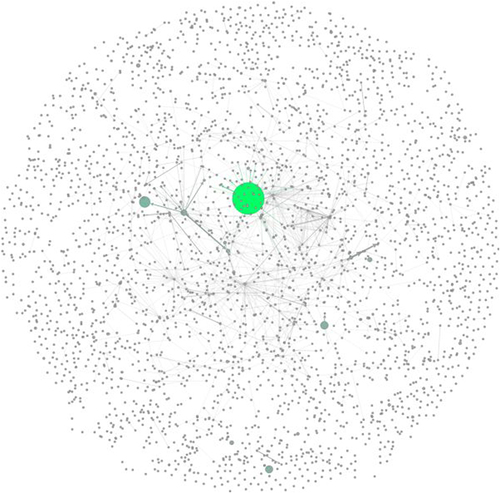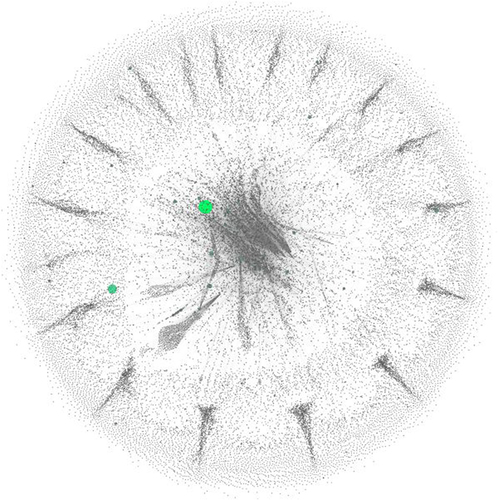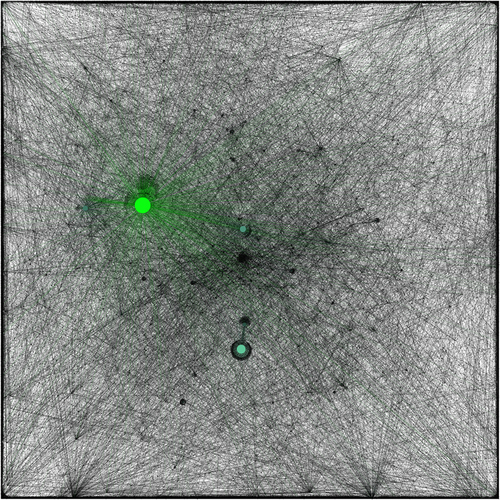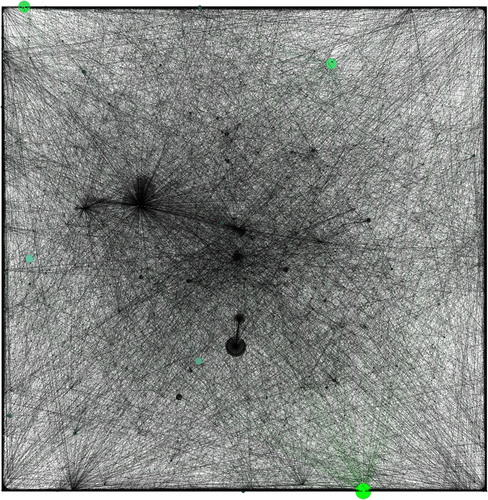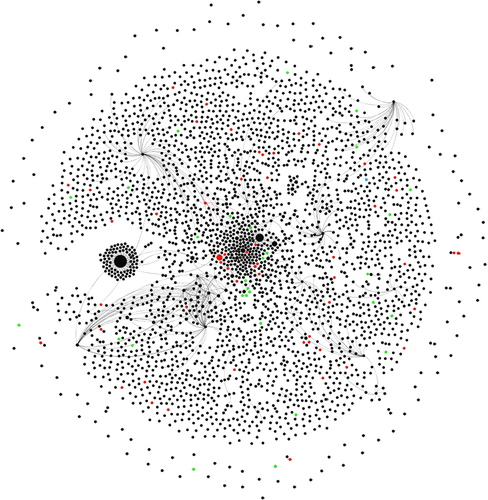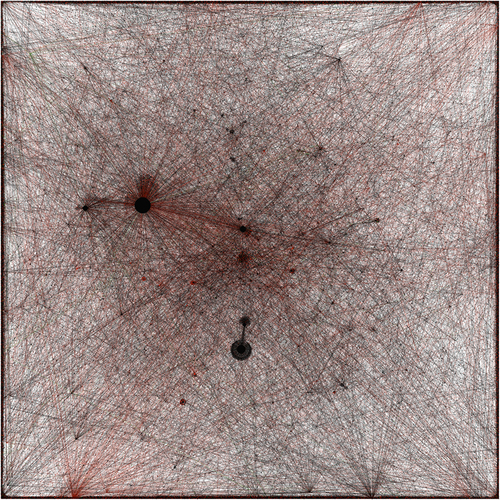ABSTRACT
Background/Aim
The first case of COVID-19 in Turkey was officially recorded on March 11, 2020. Social media use increased worldwide, as well as in Turkey, during the pandemic, and conspiracy theories/fake news about medical complications of vaccines spread throughout the world. The aim of this study was to identify community interactions related to vaccines and to identify key influences/influencers before and after the pandemic using social network data from Twitter.
Materials and methods
Two datasets, including tweets about vaccinations before and after COVID-19 in Turkey, were collected. Social networks were created based on interactions (mentions) between Twitter users. Users and their influence were scored based on social network analysis and parameters that included in-degree and betweenness centrality.
Results
In the pre-COVID-19 network, media figures and authors who had anti-vaccine views were the most influential users. In the post-COVID-19 network, the Turkish minister of health, the was the most influential figure. The vaccine network was observed to be growing rapidly after COVID-19, and the physicians and authors who had opinions about mandatory vaccinations received a great deal of reaction. One-way communication between influencers and other users in the network was determined.
Conclusions
This study shows the effectiveness and usefulness of large social media data for understanding public opinion on public health and vaccination in Turkey. The current study was completed before the implementation of the COVID-19 vaccine in Turkey. We anticipated that social network analysis would help reduce the “infodemic” before administering the vaccine and would also help public health workers act more proactively in this regard.
1. Introduction
The outbreak of COVID-19, caused by the SARS-CoV-2 virus, in China at the end of 2019 spread rapidly throughout the world and was declared a pandemic by the World Health Organization (WHO) on March 11, 2020.Citation1 On the same date, the first COVID-19 case in Turkey was officially recorded.Citation2
Due to the closures that were initiated due to the pandemic, as well as the social distance measures taken, the use of social media platforms to disseminate information increased.Citation3 According to 2021 data, the use of social media increased by 11% around the world compared to the previous year, reaching 4.2 billion users (54%). Interestingly, social media usage in Turkey increased by 13% and reached 60 million users (70.8%).Citation4
The use of social media platforms has been shown to increase significantly in situations such as natural disasters and crises, where fast information flow is needed. The use of social media is considered an opportunity in health crises due to the ease of accessing up-to-date information.Citation5,Citation6
For example, during SARS, Ebola, and H1N1 outbreaks, there was an increase in the use of social media and compliance with protective measures such as hand-washing, face mask-wearing, and social distancing.Citation7–9 Similarly, in the COVID-19 pandemic, the use of personal protective equipment, social distancing, and even medical treatment protocols spread rapidly thanks to social media. International organizations, such as the WHO and the Center for Disease Control, shared information about COVID-19 on their websites, and and it was disseminated to the most remote corners of the world for use. However, social media has also led to the rapid spread of uncontrolled misinformation about the pandemic, unfounded claims about the diagnosis, treatment, prevention, origin, and transmission of the virus, conspiracy theories, and pseudoscience-based treatments.Citation10–13
The term “infodemic,” which is defined by WHO as “too much information including false or misleading information in digital and physical environments during a disease outbreak,” came to the forefront with COVID-19, as the WHO announced in mid-February 2020 that both the new coronavirus pandemic and the infodemic were moving swiftly.Citation6,Citation14
Treatment options and the advent of vaccines have caused conspiracy theories and misinformation about vaccines on social network sites.Citation15 There was an increase in expert opinions throughout the national media centered on statements from anti-vaccine groups, conspiracy theories, and false perceptions about the speed of vaccine development, long-term side effects, and difficulties related to the COVID-19 vaccine.
The internet and social media are extremely effective for disseminating information about the safety and efficacy of vaccines. However, it is difficult to change negative attitudes toward vaccines when individuals have been exposed to misinformation.Citation16–18 It is highly probable that the parents who use the internet to obtain information about vaccines believe that there is no need to vaccinate healthy children and that the vaccine is more harmful than beneficial.Citation19
To be able to learn and manage the perceptions of societal risks during the COVID-19 pandemic, monitoring social discourse on social media is of great value.Citation20 By allowing users to create and share content, social media exposes individuals to an ever-increasing amount of information and plays a role in spreading misinformation by bringing together people with similar thoughts, thus making them feel empowered.Citation6,Citation21,Citation22
Social network analysis (SNA) is an analytical method that is used to study the structure of social networks and the relationships between actors. Actors are represented by nodes, and relationships are represented as an edge between two actor nodes.Citation23 For example, actors can be workers from a business, and relationships can involve sending e-mails. If a worker sends an e-mail to another coworker, this can be represented by two nodes connected with an edge with an arrow pointing to the receiver.
Researchers have frequently used SNA for various research from different data sources, and research on Twitter has been growing in parallel. Twitter is one of the most influential social networks. All the content created can be accessed publicly, which enables researchers to gather information without the need for consent. Twitter is a micro-blogging site where users write about topics and interact with each other. They use hashtags, mentions, replies, and retweets, and follow other users to interact with them. Twitter can be a powerful tool for sharing information. One purpose of SNA is to identify influencers. The definition of influence on Twitter is “the potential of an action of a user to initiate a further action by another user.”Citation24 One of the metrics for measuring the influence is the markers of influence. These are physical representations of the potential for further action mentioned in the definition of influence. These markers are replies, retweets, mentions, and attributions.
Twitter is a network that exposes a user to messages written by selected individuals through the pathways formed by one user “following” another user. This network allows the examination of tweets with content related to vaccines in the context of a social relations network.Citation25
There has been a worldwide increase in studies related to interactions between social media and vaccines. These studies are based mostly on content analysis. No studies have been published on this subject in Turkey; therefore, information about online social networks related to vaccines in Turkey, the influential people or communities in this area, and the spread of evidence-based information and practices is limited. The aim of this study, based on SNA, was to determine the community interactions related to vaccines, to identify key influences and influencers before and after the COVID-19 pandemic, and to better understand communication about vaccines on Twitter.
2. Materials and methods
2.1. Ethical considerations
Messages, texts, or images shared on social media blogs, forums, etc. are considered part of the shared public domain. We collected data that were publicly posted on Twitter. Due to the nature of the information sent and the platform used, we assume that Twitter users expect the virtual space to be open to the public.Citation26 We changed the name of the Twitter user’s account to maintain his/her privacy.
2.2. Dataset
We collected two datasets with the keyword “aşı” (vaccine) on vaccination between June 1, 2019, and March 11, 2020, and March 11, 2020, and January 1, 2021. To distinguish how far back our data would go from the first COVID-19 case in Turkey, we first included the first three months of the pandemic, but the dataset was rather small, so we decided to use that as a reference and go back further. While experimenting with different timeframes through snowball sampling, we saw that after nine months, the dataset slowly grew larger. This indicates that before COVID-19, vaccine opposition on Turkish Twitter was rather low, so we decided that nine months before the first COVID-19 case should be the timeframe we use. For the second timeframe, the start date was the date of the first COVID-19 case in Turkey, and data were collected up till the date of this research to capture the recent state. The first dataset included all tweets before COVID-19, and the second dataset included all tweets following the start of COVID-19. These datasets were collected with Twint, an open-source Python package that enabled us to collect data without Twitter’s data restrictions. Twint is widely used in the literature as a web crawling method.Citation27,Citation28 A total of 131,172 tweets were gathered before COVID-19, and 955,305 tweets were gathered after the start of COVID-19. All our tweets were in Turkish, and none of the tweets were processed or filtered before the data preparation process. Tweet data included information such as its sender, date, time, tweet, mentions, hashtags, number of replies, list of users mentioned, etc.
2.3. Data preparation
To create a social network from tweets, we first cleaned irrelevant tweets from the datasets. We wrote Python code to obtain a list of all the hashtags used in the tweets. These hashtags represent information about what was tweeted. We filtered relevant hashtags, based on our research topic and only accepted tweets that contained relevant hashtags. When we searched “aşı” (vaccination) on Twitter, we also got results for “ası” and “asi” because of Turkish-only characters. We had many tweets that were irrelevant to our topic. For example, the “asi” hashtag is homonymous with “aşı” but they have different meanings. When the hashtags related to the vaccine were filtered, it was found that the hashtags #asi and #asi were still actively used by the fans of the TV series “Asi” (The title of TV series is Asi, a Turkish word meaning “rebel,” but its Turkish spelling is confused with the English spelling of the Turkish word “aşı” for vaccine as “asi”), which was popular in Turkey in the past. Therefore, we compiled a list of all hashtags used before and after COVID-19. A total of 8393 hashtags for the before period and 29956 hashtags for the after period were compiled. We filtered hashtags that appeared only once to reduce the number of hashtags. Then, we selected only tweets that contained relevant hashtags. This enabled us to eliminate irrelevant tweets about vaccinations. A total of 558 hashtags were selected. We decided that tags were relevant through peer review. For every hashtag selected, we checked its relevance to its context by reading tweets with that hashtag. While checking their relevance, we also coded the hashtags as pro or anti by looking at the context in which they were used. We did not include neutral hashtags because we wanted to focus on vaccine opposition; users who did not use pro or anti hashtags were marked as neutral. A list of the top 20 hashtags can be seen in .
Table 1. Top 20 selected relevant hashtags based on their frequency
Childhood vaccines were searched with hashtags that included #chickenpox, #MMR, #measles, #rubella, and #polio. However, it was seen that only the hashtags for #rabies and #flu vaccines were included in the top 20 list ().
After filtering relevant tweets, we wrote Python code that takes tweets and moves them to a new CSV file, which can be read as a social network by Gephi.Citation29 Social networks were created based on the interactions (mentions) between users on Twitter.
To map the anti-vaccine content in these datasets, we again checked all hashtags and marked users who tweeted with pro/anti-vaccination hashtags. Pro/anti-vaccination hashtags were also selected through peer review ().
Table 2. Examples for anti- and pro-hashtags before COVID-19
Table 3. Examples for anti- and pro-hashtags after COVID-19
2.4. Using SNA to understand the vaccination network
In our case, influence is weighted in-degree. Weighted in-degree is the sum of all edges coming to the node with their weights and corresponds to the sum of all replies and mentions of that specific user in our case. Users with a high-weighted degree have many tweets that replied to or mentioned other users or that were replied to or mentioned by other users through high interaction with other users. Two types of scenarios can occur for influencers. They can have a high in-degree, which means that the user gets many replies or mentions, and a low out-degree, which means that the user does not reply or mention back. The second scenario is that they can have a high in-degree/high out-degree, which means they have high interaction, both coming to them and going from them.
These influencers are users with many followers and are in important positions regarding the spread of information. When they tweet, many other users see it, which gives the tweeter more potential for influence. Twitter’s follower count is the most basic metric for influence.Citation24
For example, Riddell et al. conducted research to identify the most influential emergency physicians on Twitter by measuring the user’s in-degree betweenness centrality and eigenvector centrality.Citation30 Furthermore, Sanawi et al. identified influencers on vaccination topics and used the user’s in-degree and eigenvector centrality in their analysis.Citation31
Another metric for influence is betweenness centrality. SNA research points out that a central position implies the control of information flow. Xu et al. conducted research on Twitter and betweenness centrality and influence. They found that higher betweenness centrality leads to a diverse range of information and enables influencers to interact with a bigger audience.Citation32
Our last metric is degree distribution. Degree distribution is the visual representation of nodes and their degrees in a sorted histogram representation. Degree distribution shows the number of highly connected nodes and fewer connected nodes.
2.5. Constructing networks and visualization
We created two social networks from the before and after COVID-19 datasets. Because Twitter is a platform where users create and share content and interact with others, we created a node for every user. Every node has a unique identity (ID) that corresponds to that user’s Twitter ID, and no two users can have the same ID. Nodes also contain information, such as the number of tweets that a particular user tweeted on vaccinations during the indicated time frames. After creating nodes, we added edges that represented the interactions between users. When a user mentions or replies to a user, an edge is drawn from who wrote the tweet to the user who was mentioned or retweeted. There are also several interactions for every edge. The total number of interactions between two users is stored as weights. We categorized users as anti-vaccination, pro-vaccination, mixed, and neutral. If users tweet with a related hashtag, then that node is categorized in the related category. If users tweeted both anti and pro hashtags, they were marked as mixed. Finally, if they did not use anti or pro hashtags, they were categorized as neutral. We used Gephi to visualize and analyze this social network. Visualizations of both networks can be seen in . Constructing networks from mentions and retweets is common in SNA, and many different examples can be seen in the literature.Citation29
3. Results
3.1. Information on networks before/after COVID-19
Before COVID-19, the social network had 3,070 nodes and 1,252 edges. The diameter of the network was 2 and the average path length was 1.118, while the average degree was 0.408. The average clustering coefficient was 0.008. All of these metrics were calculated by Gephi.Citation33
After COVID-19, the social network had 38,241 nodes and 18,716 edges. The diameter of the network was 12 and the average path length was 3.258, while the average degree was 0.489. Our degree distribution graphs resemble a power law presence, which also supports the findings of influencers in the present network.
3.2. Finding the most influential users through networks
To find the most influential users in the network, certain metrics are used by researchers. One of these metrics is in-degree. In-degree represents the number of incoming edges to that node.Citation34 For our example, it is the number of mentions and replies the user has. A higher in-degree means that the user received many mentions and replies from other users. The top 10 most influential users are shown in , which is based on their in-degree and betweenness centrality scores in the pre-COVID-19 network. Visualization of the pre-COVID-19 Twitter network according to in-degree and betweenness centrality parameters is demonstrated in .
Table 4. Top 10 most influential users in pre-COVID-19 Twitter network according to in-degree and betweenness centrality measures
Figure 3. Visualization of pre-COVID-19 network according to In-degree. Size and color of the nodes are bigger and greener the more in-degree increases.
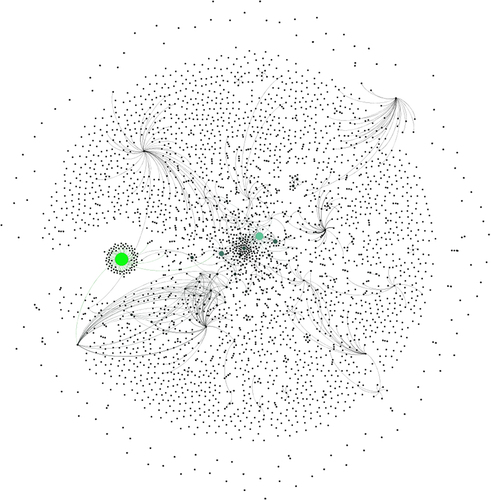
Figure 4. Visualization of pre-COVID-19 network according to betweenness centrality. Size and color of the nodes are bigger and greener the more betweenness centrality increases.
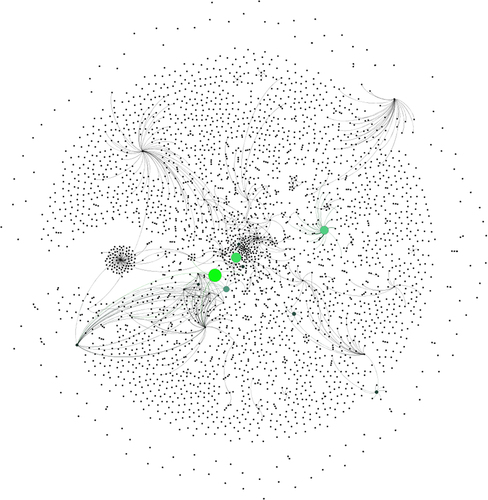
A similar analysis was performed in the post-COVID-19 Twitter network. The top 10 most influential users are shown in and are based on the in-degree and betweenness centrality scores.Citation35 Visualization of the post-COVID-19 Twitter network according to in-degree and betweenness centrality parameters is demonstrated in .
Table 5. The top 10 most influential users in post-COVID-19 Twitter network according to in-degree and betweenness centrality measures
3.3. Pro vs. Anti-vaccination supporters among networks
Members of our network utilized many hashtags related to what they were talking about. These hashtags also served as a summary of the tweet’s content. By looking at which users utilized pro-vaccination, anti-vaccination, or both, we found that in the pre-COVID-19 network, the number of only pro-or anti-vaccination supporters was low. However, after COVID-19, there was a huge increase in these numbers. After COVID-19, anti-vaccine supporters were 22 times greater than pro-vaccine supporters. In addition, anti-vaccination supporters made up 26.51% of the networks in the post-COVID-19 network compared to 1.7% in the pre-COVID-19 network (). Anti-and pro-vaccination supporters can be visualized in in the pre-COVID-19 and post-COVID-19 networks, respectively.
Table 6. Users and network statistics before and after COVID-19 in Turkey
4. Discussion
Immunization services are recognized as one of the most important and cost-effective public health achievements in the prevention of vaccine-preventable diseases and related deaths. However, in recent years, concerns about the safety and side effects of vaccines have started to spread rapidly on the internet. The WHO indicated that anti-vaccination is one of the 10 problems threatening global health in 2019.Citation36 Anti-vaccination movements have become a global trend and have been reported by approximately 90% of countries in the world.Citation37 Especially during the pandemic, news and rumors about vaccines became more visible on social media, opposition to the COVID-19 vaccine increased, and there were concerns that this situation would negatively affect vaccination studies.Citation38
In a study conducted in Denmark, France, Germany, Italy, Portugal, the Netherlands, and the UK in April 2020, 7.2% of the respondents stated that they did not want to be vaccinated for COVID-19.Citation39 Another study conducted in the USA revealed that 12% of those who participated in the study would not be vaccinated, and 82% were worried about the safety of the vaccine.Citation40 In the USA, individuals living in rural areas with a low income and low education levels are more hesitant to get the COVID-19 vaccine; in Australia, people living with a low income and disadvantaged areas and women are more hesitant to get the vaccine than men.Citation41,Citation42
In Turkey, as in other countries, misinformation about the COVID-19 outbreak appeared on the internet and in social networks; some groups say that there is no virus, and there are rumors that the vaccine will have a microchip to control us. For example, a group of people tweeted, “They will put chips inside us, I don’t trust the vaccine.” Other users tweeted, “If you don’t get vaccinated, you will be a traitor. If you get vaccinated, you will be chipped.” In a study conducted with vaccines in England and Turkey in the first six months of the pandemic, 31% of the participants in Turkey and 14% of those in the UK emphasized that they were undecided about getting a COVID-19 vaccine.Citation43 According to a study conducted in Turkey between December 25–29, 2020, when the vaccination process had not started yet, 14% of the participants never thought of getting vaccinated.Citation44
The number of Twitter users in Turkey has reached 13.6 million, which is 7th in rank among the countries with the most Twitter users in the world.Citation45 The findings of the present study show that society is focusing largely on vaccine-related issues on the COVID-19 pandemic, and public interest is increasing in the areas related to the vaccine.
When the pre-and post-COVID-19 network characteristics were examined, it was observed that the density of the network, both peripheral and central, increased after COVID-19. In addition, network diameter and average path length increased, which points out that the network grew bigger with better-connected users.
Before COVID-19, anti-vaccine proponents gathered around anti-vaccine writers and took a stand against those who supported compulsory vaccination after COVID-19.
For example, a journalist-author whose book about the side effects of vaccines (published in November 2019) was at the forefront of the posts of anti-vaccine supporters in the pre-COVID-19 period. With the publication of the anti-vaccine book Vaccine Whistleblower (#cdcwhistleblower) and the movie Vaxxed (#vaxxed) published in the USA between 2014–2015, there was a steady increase in the anti-vaccine discourse on Twitter in the time period of the study.Citation46 Similar to the example given in our study, the author of an anti-vaccine book published in Turkey was highlighted by those who defended the view against the vaccine.
Before COVID-19 cases were detected in Turkey, multiple hashtags, including #coronavirus, #koronavirus, #covid19, and #çinaşısı were gaining tweet momentum. In our study, in the period before March 11, 2020, an epidemic of COVID-19 had started in Europe and Iran, thus affecting Twitter users.
It was on January 13, 2021 that the first coronavirus vaccine was made in Turkey, and by this date the study data had been completed. Even though the Synovac ((Chinesevaccine) and BioNtech (Pfizer) were not yet available in Turkey, the hashtags #pfizer and #Çinaşisi took place among the ones mostly preferred by Turkish Twitter users. The reason for this is thought to have been that the Turkish government intended to purchase these vaccines for use in the country and thus the public may have grown curious about the news of them. From our perspective, the discourse on vaccines in social media, which started before the vaccine arrived in the country, has changed over time and is linked to unfolding daily life events and updated views on vaccines.
It was noteworthy that pre-and post-COVID-19 childhood vaccines (#chickenpox, #MMR, #measles, #rubella, #polio, and #polio) especially the measles vaccine, were not included in the network. Whereas, in 2019, measles cases had increased all over the world, including Turkey, and some studies have shown the effect of this situation on Twitter.Citation46,Citation47 We are of the opinion that further research on the reflections of childhood immunization programs and vaccines on social media is required.
There is no legal regulation on vaccinations created and recommended for children by the Ministry of Health in Turkey. In other words, vaccination is not a mandatory practice. On the other hand, in the post-COVID-19 period, hashtags were mostly about concerns regarding the obligation to receive the vaccine, which were shared by users. It has been determined in our study that accounts advocating the view that the COVID-19 vaccine should be obligatory have received intense criticism. Similar to our study, mandatory vaccination in Italy after the 2015 measles epidemic led to polarized and politicized reactions.Citation48 It was also observed that most tweets about the vaccine were posted during the period when compulsory vaccination was legally approved in Italy.Citation49 In our study, while most of the tweets were neutral toward vaccination, polarized users tended to post more about anti-vaccine and pro-vaccine topics following COVID-19 than they did before.
The user accounts that receive the most interaction (in-degree) in the network before and after COVID-19 are those of various newspapers, media members such as writers and TV presenters, official organizations, and authors who write books about the side effects of vaccines. After COVID-19, the Minister of Health received the highest level of activity within the network in Turkey. Before and after the first case emerged in Turkey, the Minister of Health made frequent press statements. Especially after the first case, these statements were made almost every night and broadcast live on TV. The whole country followed these statements regularly. Decisions regarding the pandemic period, which were actively announced on social media and traditional media, set the agenda. The president’s account also received a high volume of activity on Twitter following COVID-19. Discussion about the vaccine was politicized by some users on Twitter, making politicians appear more influential within the network. Vaccines, COVID-19 treatment, and pandemic measures have become part of the political debate in many parts of the world. It was determined in this study that various opposing press and media outlets were mentioned most of all in the post-COVID-19 period.
Media and press organizations which most strongly controlled the information flow around the network were found to be active before and after COVID-19 in betweenness centrality. Their activity shows the degree of the presence of an actor in the network among other actors. According to betweenness centrality, the highest interaction on Twitter was R.T., Minister of Health. Despite the active use of social media by the Minister of Health, few physicians in the network drew attention. Compared to other occupational groups, health professionals are unwilling to use social media for professional purposes.Citation50 Studies have shown various concerns, such as misinformation, unprofessionalism and time as potential reasons for the health professionals’ unwillingness to use it.Citation51 Since social media has become a big part of our daily lives, medicine, education, the active participation of physicians in this field has become a necessity.Citation52
The YouTube platform and physicians who conducted vaccination studies were added to the betweenness centrality table after COVID-19. Users shared content containing the word “vaccine” and the phrase “@YouTube.” It was thought that the removal of videos that made negative comments about the COVID-19 vaccine might have pushed users toward this action. It should be noted that Twitter discussions are constantly evolving and potentially changing weekly.
When the interactions of users in the network after COVID-19 were examined, the rate of those who did not interact with other users was observed to be 80.59%. This value was very close to that of the pre-COVID-19 network. This shows that the COVID-19 pandemic did not affect the interaction rate among users. When the interaction types were examined, 17.4% of the interactions between users were in the form of direct responses to another user. Direct interactions, such as mentions, are used to construct networks in many research studies.Citation53 The interaction of influencers on the network, as far as we could see, consisted largely of users talking about influencers. We could not observe influencers replying to or mentioning other users. This shows that there was a one-way flow of information between the influencers and network members. The ratio of users against vaccine in the network to users for the vaccine was 22.65. In other words, for every 22 anti-vaccine users, there was one user who supported the vaccine. It has been determined in our study that while the number of anti-vaccine users increased 1400% in the post-COVID-19 period, the number of users supporting the vaccine increased by only 60%.
This shows that in the vaccine discussions that started with COVID-19, conspiracy theories, information pollution, and rumors spread on social media increased the opposition to vaccines and made them visible on social media.
4.1. Conclusion
We used SNA to analyze vaccine sensitivity in the population. This study investigated the ongoing vaccine discourse on the Twitter network, examined society’s opinions about vaccines, and identified key players. We found increased interactions on vaccinations after the COVID-19 pandemic, that anti-vax content increased during this period, and that a key role in the network was played by the Minister and Ministry of Health and media and press organizations.
In our study, we observed that there was one-sided communication between influencers and other users. Experts, institutions, and organizations dealing with public health will be more effective against anti-vaccine discourses if they advise against false information on social media using their own accounts. In addition, well-known people, scientists, officials, and physicians should be encouraged to actively share using traditional media and social media. In particular, physicians should be encouraged to actively use social media, and their training on how to use social media can be supported.
Our study was completed before January 13, 2021, the date of the first COVID-19 vaccination in Turkey. For this reason, we predict that SNA will help reduce misinformation regarding vaccines and all and help public health workers to act more proactively before vaccination.
4.2. Principal findings
Interest in vaccination increased after the pandemic, as shown by the increase in tweets on the topic.
The official social media account of the Ministry of Health was key to linking the network to the vaccination topic.
It was observed that the number of physicians who set the agenda regarding the vaccine during the study period was very few, and the physicians and authors who had attitudes toward mandatory vaccination received a great deal of reaction.
4.3 Limitations
The most important limitation of this study is that it was time dependent. Public sentiment on Twitter can change over time. Vaccination-related network information available on Twitter provides an overview of vaccine perception, but we assume that it may not reflect a broad vaccine perception in the general population as our study is limited to Twitter. Our study is based on network analysis only; no content analysis was performed. In the future, studies that include content analysis can be carried out. The use of Twitter is one of the limitations of our study. Our classification of pro-and anti-vaccination users is based only on the hashtags used without an analysis of the content of tweets. A no-vaccination or a pro-vaccination hashtag can be used in a tweet with an opposite meaning. Also, from a methodological point of view, classifying users as pro or anti could be done in alternative ways. Because we were experienced with content analysis and not experienced with sentiment analysis, we classified hashtags and tweets by peer review. Another limitation is that this study was based only on Twitter analysis. Since different platforms are preferred by various audiences, we think that future vaccine networks and data studies will encourage the analysis of public sentiment on other social media platforms. This study considers the two periods before and after the pandemic as a whole and does not consider temporal variations during the two periods.
Supplemental Material
Download MS Word (31.2 KB)Disclosure statement
No potential conflict of interest was reported by the author(s).
Supplementary material
Supplemental data for this article can be accessed on the publisher’s website at https://doi.org/10.1080/21645515.2021.2025008.
Additional information
Funding
References
- World Health Organization-Director. General’s opening remarks at the media briefing on COVID-19. Geneva WHO Director-General’s opening remarks at the media briefing on COVID-19 – 26 February 2021. [ accessed 2021 May 3]. https://www.who.int/director-general/speeches/detail/who-director-general-s-opening-remarks-at-the-media-briefing-on-covid-19 .
- Ministry-of-Health-of-Turkey. TC Sağlik Bakanliği COVID-19 Bilgilendirme Sayfasi. 2020 [accessed 2021 Apr 27]. https://covid19.saglik.gov.tr/TR-66113/covid-19.html .
- Abd-Alrazaq A, Alhuwail D, Househ M, Hamdi M, Shah Z. Top concerns of tweeters during the COVID-19 pandemic: infoveillance study. J Med Internet Res. 2020 Apr 21;22(4):e19016. PMID: 32287039; PMCID: PMC7175788. doi:10.2196/19016.
- We are social digital 2021 July global statshot report. [ accessed 2021 Jul 22]. https://wearesocial.com/digital-2021 .
- Denecke K, Krieck M, Otrusina L, Smrz P, Dolog P, Nejdl W, Velasco E. How to exploit twitter for public health monitoring? Methods Inf Med. 2013;52(4):326–13. Epub 2013 Jul 23. PMID: 23877537. doi:10.3414/ME12-02-0010.
- Guess AM, Nyhan B, O’Keeffe Z, Reifler J. The sources and correlates of exposure to vaccine-related (mis)information online. Vaccine. 2020 Nov 17;38(49):7799–805. Epub 2020 Oct 22. PMID: 33164802; PMCID: PMC7578671. doi:10.1016/j.vaccine.2020.10.018.
- Collinson S, Heffernan JM. Modelling the effects of media during an influenza epidemic. BMC Public Health. 2014 Apr 17;14:376. PMID: 24742139; PMCID: PMC4001363. doi:10.1186/1471-2458-14-376.
- Cui J, Sun Y, Zhu H. The impact of media on the control of infectious diseases. J Dyn Differ Equ. 2008;20(1):31–53. Epub 2007 May 18. PMID: 32214759; PMCID: PMC7088267. doi:10.1007/s10884-007-9075-0.
- Kim L, Fast SM, Markuzon N. Incorporating media data into a model of infectious disease transmission. PLoS One. 2019 Feb 4;14(2):e0197646. PMID: 30716139; PMCID: PMC6361417. doi:10.1371/journal.pone.0197646.
- Brennen JS, Simon FM, Howard PN, Nielsen RKT. Sources, and claims of COVID-19 misinformation. Oxford Univ Press; 2020 Apr. p .
- Bridgman A, Merkley E, Loewen PJ, Owen T, Ruths D, Teichmann L, Zhilin O. The causes and consequences of COVID-19 misperceptions: understanding the role of news and social media. Harvard Kennedy School (HKS) Misinformation Rev. 2020:1. doi:10.37016/mr-2020-028.
- Jargin SV, Murphy J. International perspectives and initiatives: the state of medical libraries in the former Soviet Union. Health Info Libr J. 2010;27:244–48. doi:10.12691/ajms-1-2-1.
- Tasnim S, Hossain MM, Mazumder H. Impact of rumors and misinformation on COVID-19 in social media. J Prev Med Public Health. 2020 May;53(3):171–74. Epub 2020 Apr 2. PMID: 32498140; PMCID: PMC7280809. doi:10.3961/jpmph.20.094.
- González-Padilla DA, Tortolero-Blanco L. Social media influence in the COVID-19 pandemic. Int Braz J Urol. 2020 Jul;46(suppl.1):120–24. PMID: 32550706; PMCID: PMC7719982. doi:10.1590/S1677-5538.IBJU.2020.S121.
- Salathé M, Bengtsson L, Bodnar TJ, Brewer DD, Brownstein JS, Buckee C, Campbell EM, Cattuto C, Khandelwal S, Mabry PL, et al. Digital epidemiology. PLoS Comput Biol. 2012;8:e1002616. doi:10.1371/journal.pcbi.1002616.
- Chew C, Eysenbach G. Pandemics in the age of Twitter: content analysis of Tweets during the 2009 H1N1 outbreak. PLoS One. 2010 Nov 29;5(11):e14118. PMID: 21124761; PMCID: PMC2993925. doi:10.1371/journal.pone.0014118.
- Del Vicario M, Bessi A, Zollo F, Petroni F, Scala A, Caldarelli G, Stanley HE, Quattrociocchi W. The spreading of misinformation online. Proc Natl Acad Sci U S A. 2016;113:554–59. PMID: 26729863. doi:10.1073/pnas.1517441113.
- Kata A. A postmodern Pandora’s box: anti-vaccination misinformation on the Internet. Vaccine. 2010 Feb 17;28(7):1709–16. Epub 2009 Dec 30. PMID: 20045099. doi:10.1016/j.vaccine.2009.12.022.
- Jones AM, Omer SB, Bednarczyk RA, Halsey NA, Moulton LH, Salmon DA. Parents’ source of vaccine information and impact on vaccine attitudes, beliefs, and nonmedical exemptions. Adv Prev Med. 2012;2012:932741. Epub 2012 Oct 2. PMID: 23082253; PMCID: PMC3469070. doi:10.1155/2012/932741.
- Pascual-Ferrá P, Alperstein N, Barnett DJ. Social network analysis of COVID-19 public discourse on Twitter: implications for risk communication. Disaster Med Public Health Prep. 2020 Sep;10:1–9. Epub ahead of print. PMID: 32907685; PMCID: PMC7674807. doi:10.1017/dmp.2020.347.
- Himelboim I, McCreery S, Smith M. Birds of a feather tweet together: integrating network and content analyses to examine cross-ideology exposure on Twitter. J Comput-Mediated Commun. 2013;18:40–60. doi:10.1111/jcc4.12001.
- Karafillakis E, Martin S, Simas C, Olsson K, Takacs J, Dada S, Larson HJ. Methods for social media monitoring related to vaccination: systematic scoping review. JMIR Public Health Surveill. 2021 Feb 8;7(2):e17149. PMID: 33555267; PMCID: PMC7899807. doi:10.2196/17149.
- O’Donohoe S. Netnography: doing ethnographic research online. Int J Advertising. 2010;29:328–30. doi:10.2501/S026504871020118X.
- Leavitt A, Burchard E, Fisher D, Gilbert S 2009 The influentials: new approaches for analyzing influence on twitter (Web Ecology Project)
- Wilson K, Keelan J. Social media and the empowering of opponents of medical technologies: the case of anti-vaccinationism. J Med Internet Res. 2013 May 28;15(5):e103. PMID: 23715762; PMCID: PMC3668617. doi:10.2196/jmir.2409.
- Zimmer M, Kinder-Kurlanda K. Internet research ethics for the social age. Switzerland: Peter Lang Publishing, Incorporated; 2017.
- Houghton DJ, Hodder A. Understanding trade union usage of social media: a case study of the public and commercial services union on Facebook and Twitter. New Technol, Work Employment. 2021;36:219–39. doi:10.1111/ntwe.12209.
- Yao W, Qian S. From Twitter to traffic predictor: next-day morning traffic prediction using social media data. Transp Res Part C Emerging Technol. 2021;124:102938. doi:10.1016/j.trc.2020.102938.
- Yang A, Saffer AJ. Standing out in a networked communication context: toward a network contingency model of public attention. New Media Soc. 2020. doi:10.1177/1461444820939445.
- Riddell J, Brown A, Kovic I, Jauregui J. Who are the most influential emergency physicians on Twitter? West J Emergency Med. 2017:18. doi:10.5811/westjem.2016.11.31299.
- Sanawi JB, Samani MC, Taibi M. #Vaccination: identifying influencers in the vaccination discussion on twitter through social network visualisation. Int J Bus Soc. 2017;18:718–26.
- Xu WW, Sang Y, Blasiola S, Park HW. Predicting opinion leaders in Twitter activism networks:the case of the Wisconsin recall election. Am Behav Sci. 2014;58:1278–93. doi:10.1177/0002764214527091.
- Brandes U. A faster algorithm for betweenness centrality. J Math Sociol. 2001;25:163–77. doi:10.1080/0022250X.2001.9990249.
- Bastian M, Heymann S, Jacomy M. Gephi: an open source software for exploring and manipulating networks. In: Third international AAAI conference on weblogs and social media. 2009. https://www.aaai.org/ocs/index.php/ICWSM/09/paper/view/154 .
- Wasserman S, Faust K. Social network analysis: methods and applications. Struct Anal Soc Sci. 1994. doi:10.1017/CBO9780511815478.
- Centers-for-Disease-Control-and-Prevention-(CDC). Ten great public health achievements–United States, 1900-1999. MMWR Morb Mortal Wkly Rep 1999;48:241–43.
- Lane S, MacDonald NE, Marti M, Dumolard L. Vaccine hesitancy around the globe: analysis of three years of WHO/UNICEF joint reporting form data-2015–2017. Vaccine. 2018;36:3861–67. doi:10.1016/j.vaccine.2018.03.063.
- Ball P. Anti-vaccine movement could undermine efforts to end coronavirus pandemic, researchers warn. Nature. 2020 May;581(7808):251. PMID: 32405043. doi:10.1038/d41586-020-01423-4.
- Neumann-Böhme S, Varghese NE, Sabat I, Barros PP, Brouwer W, van Exel J, Schreyögg J, Stargardt T. Once we have it, will we use it? A European survey on willingness to be vaccinated against COVID-19. Eur J Health Econ. 2020 Sep;21(7):977–82. PMID: 32591957; PMCID: PMC7317261. doi:10.1007/s10198-020-01208-6.
- Jones HE, Manze M, Ngo V, Lamberson P, Freudenberg N. The impact of the COVID-19 pandemic on college students’ health and financial stability in New York City: findings from a population-based sample of City University of New York (CUNY) students. J Urban Health. 2021 Apr;98(2):187–96. Epub 2021 Feb 11. PMID: 33570739; PMCID: PMC7877316. doi:10.1007/s11524-020-00506-x.
- Edwards B, Biddle N, Gray M, Sollis K. COVID-19 vaccine hesitancy and resistance: correlates in a nationally representative longitudinal survey of the Australian population. PLoS One. 2021;16:e0248892. doi:10.1371/journal.pone.0248892.
- Khubchandani J, Sharma S, Price JH, Wiblishauser MJ, Sharma M, Webb FJ. COVID-19 vaccination hesitancy in the United States: a rapid national assessment. J Community Health. 2021 Apr;46(2):270–77. Epub 2021 Jan 3. PMID: 33389421; PMCID: PMC7778842. doi:10.1007/s10900-020-00958-x.
- Sa Salali GD, Uysal MS. COVID-19 vaccine hesitancy is associated with beliefs on the origin of the novel coronavirus in the UK and Turkey. Psychol Med. 2020 Oct 19;1–3. Epub ahead of print. PMID: 33070804; PMCID: PMC7609204. doi:10.1017/S0033291720004067.
- Ipsos. Koronavirüse Karşı Aşı Yaptırma Eğilimi Yükselişte. 2021 [accessed 2021 Jun 17]. https://www.ipsos.com/tr-tr/koronaviruse-karsi-asi-yaptirma-egilimi-yukseliste .
- Journo. Sosyal medya kullanıcı sayıları: türkiye ve dünyada son durum. 2020 [accessed 2021 Jun 28. https://journo.com.tr/instagram-twitter-facebook-snapchat-kullanici-sayisi-turkiye .
- Gunaratne K, Coomes EA, Haghbayan H. Temporal trends in anti-vaccine discourse on Twitter. Vaccine. 2019 Aug 14;37(35):4867–71. Epub 2019 Jul 9. PMID: 31300292. doi:10.1016/j.vaccine.2019.06.086.
- Global strategy for comprehensive vaccine-preventable disease (VPD) surveillance [Internet]. Who.int. 2021 [accessed 2021 May 17]. https://www.who.int/publications/m/item/global-strategy-for-comprehensive-vaccine-preventable-disease-(vpd)-surveillance .
- Rezza G. Mandatory vaccination for infants and children: the Italian experience. Pathog Glob Health. 2019;113:291–96. doi:10.1080/20477724.2019.1705021.
- Tavoschi L, Quattrone F, D’Andrea E, Ducange P, Vabanesi M, Marcelloni F, Lopalco PL. Twitter as a sentinel tool to monitor public opinion on vaccination: an opinion mining analysis from September 2016 to August 2017 in Italy. Hum Vaccin Immunother. 2020 May 3;16(5):1062–69. Epub 2020 Mar 2. PMID: 32118519; PMCID: PMC7227677. doi:10.1080/21645515.2020.1714311.
- Little JS, Romee R. Tweeting from the bench: Twitter and the physician-scientist benefits and challenges. Curr Hematol Malig Rep. 2020 Dec;15(6):419–23. Epub 2020 Nov 11. PMID: 33179209; PMCID: PMC7657377. doi:10.1007/s11899-020-00601-5.
- Pershad Y, Hangge PT, Albadawi H, Oklu R. Social medicine: Twitter in healthcare. J Clin Med. 2018 May 28;7(6):121. PMID: 29843360; PMCID: PMC6025547. doi:10.3390/jcm7060121.
- Gagnon K, Sabus C. Professionalism in a digital age: opportunities and considerations for using social media in health care. Phys Ther. 2015 Mar;95(3):406–14. Epub 2014 Jun 5. PMID: 24903111. doi:10.2522/ptj.20130227.
- Himelboim I, Smith MA, Rainie L, Shneiderman B, Espina C. Classifying Twitter topic-networks using social network analysis. Soc Media + Soc. 2017;3:205630511769154. doi:10.1177/2056305117691545.

